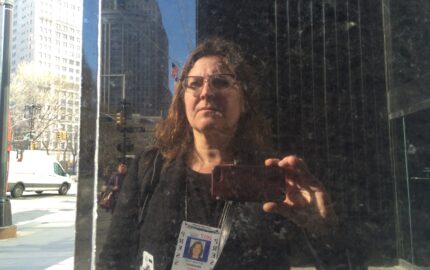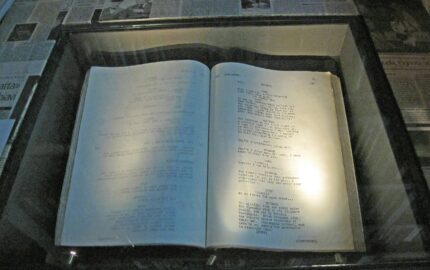Areporter friend once told me that interviewing, for him, was a “full-body sport.” His toss-off comment was a Yes! moment for me. It crystallized why, when I finished a interview, I was so drained. The exhaustion was more than the residual tension that is a standard part of any interview. Rather, it was flat-out, the kind that comes when your full self — all five physical senses plus the sixth of perception — is engaged. It maybe akin to what athletes feel following a game, when they “leave it all on the field.” When my interviews worked, I was doing more than asking questions and jotting the answers. I was trying to notice everything around me: The song on the radio, the picture on the wall, the edge in a story subject’s voice or the squint in their gaze, the spaces between what they said as much as the words they actually spoke.
Years later, I read somewhere that a small percentage — I can’t remember the actual number, but maybe around 20 percent — of what we communicate is in the words we speak. The rest is conveyed through body language, tone of voice, pauses and loop-arounds, eye contact, our surroundings and so much more. It’s an IMAX theater and surround sound and GIFs and interactive graphics all tripping over each other.
It’s so much fun — when it works. Too often, it doesn’t, either because we, as the interviewers, are distracted or, frankly, are not in the kind of shape it takes to listen, watch, notice, question, wonder and record that fully all at once.
Developing listening skills
I’ve often thought those kind of 360-degree interview skills are missing from most journalism training. I’ve long been fascinated by people who really know how to listen. Not just to check the boxes of behavior that signals listening, but to listen.
During a particularly rocky time in my life, I found a therapist I trusted. I saw her on and off for about 10 years and learned a lot about how I responded to my life, often getting in my own way. But I think the process was slower than it needed to be because I was so busy studying how she did what she did: How she listened to me, attended fully to me for 50 minutes (and then did the same for several others on the same day), got me to sort through and say what I really meant, sometimes when she hadn’t said anything at all. I took note of the shape of her questions — sometimes an open prairie, sometimes a narrow road through my tangled forest of emotion and memory. I watched when she took notes, and when she didn’t.
Since that experience, I have often thought back to the many people in my life who have certain and special listening skills: the good priests, the teachers who figured out how to motivate me, the human resource experts who could suss out a potential hire, the best editors, other reporters. Listening may be the most important skill a reporter — or any caring human being — can have. It is as complex as it is fundamental. Yet most of us only know and practice a few of its many dimensions. True listening demands a lot of us. I am keenly aware of my own limitations, and especially of the times I am simply not present or too selfish enough to really listen.
Body langauge “tells”
This musing was prompted, oddly enough, by last week’s televised debate between Vice President Kamala Harris and former President Donald J. Trump. (This is where I offer the disclaimer that this is not intended as a political statement. Your interpretation is, of course, yours.) From the moment Harris strode across the stage, entered Trump’s podium space and dared him to shake her hand, I was leaning forward: Well, this is interesting.
I spent the next 90-plus minutes watching as much as listening. As a regular and broad news reader, I didn’t expect to hear anything new about policy. And indeed, I didn’t. But how things were said — how loudly or petulantly or fiercely or passionately or clearly — kept me rapt, as did the facial expressions on display.
I sensed the message being conveyed. Or, to be honest, what I perhaps wanted that message to be. We can’t help but project, which adds to the challenge of good reporting. It’s hard to listen, and impossible to truly hear, if you’re projecting your own entrenched biases and assumptions, or filling in the blanks with what you think are the correct answers.
So I watched the debate, was taken with the show, had my own views — but tried to park assessments I had no expertise to make.
Then, the morning after, I read a piece in Politico by famed “spycatcher” Joe Navarro, a former FBI agent and international consultant on nonverbal communication. I know some people sniff about what they presume are Politico’s political leanings (another assessment I am not studied enough to make). I don’t know anything about Navarro’s. I’m sure there are more than a few out there who question the wisdom of trusting the FBI.
But rather than read Navarro for political hints, I read him as an education in how our bodies add meaning to our words. He assessed “9 Body Language Tells” on display at the debates. His brief set-up was framed like this:
Particularly in politics, words have a way of bending the truth. But the messages we communicate with our bodies — a raised eyebrow, pursed lips, a too-tight smile — speak with an authenticity rarely found in a stump speech.
From there he analyzed everything from posture to eye contact (or lack of same) to the movement of neck muscles, which I learned is called “motion in the laryngeal thyroid cartilage.” I also learned that a true smile is known, by people who study this stuff, a Duchenne smile, in which “the eyes naturally crinkle as the zygomaticus major muscle pulls the corners of the mouth into an easy grin.”
I’m not about to start making judgments by how someone squints when we’re talking. For all I know, they didn’t get much sleep, or have allergies. Acting as a sudden expert in body language is as dangerous for a reporter as acting as a trained therapist.
But how much better would our journalism — and relationships — be if we expanded our listening skills beyond asked-and-answered?



